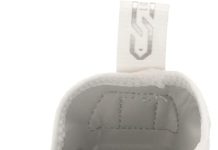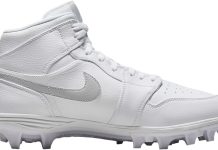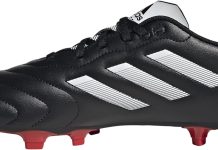Football cleats are an essential piece of equipment that plays a crucial role in our performance on the field. However, many of us may wonder when the right time is to replace them.
In this article, we will explore the signs that indicate it’s time for a new pair of football cleats, ensuring that we stay at the top of our game and excel in every match.
Signs Your Cleats Need Replacement
Review contents
Worn Out Traction
One of the most obvious signs that your cleats need replacing is worn-out traction. Over time, the studs on the bottom of your cleats can become flattened or worn down, making it difficult to maintain grip on the playing surface. This can lead to slips, falls, and decreased overall performance. If you’re sliding around on the field more than usual or struggling to make quick turns and stops, it may be time to invest in a new pair of cleats.
Lack of Support
Another sign that your cleats need replacement is a lack of support. As you wear your cleats over time, the cushioning and support within the shoe can break down, leaving you with no longer providing the necessary stability and protection. You may notice that your ankles feel less supported, your arches start to ache, or you experience increased foot and leg discomfort during and after games. If you’re finding it harder to stay on your feet or are experiencing pain while wearing your cleats, it’s a good indication that it’s time to replace them.
Visible Damage
Visible damage to your cleats is a sign that they must be replaced. This could include cracks or breaks in the sole or upper material, separation of components, excessive peeling, or a loose or detached sole. If you notice any signs of damage that cannot be repaired, replacing your cleats is essential to ensure your safety and performance on the field.
Uncomfortable Fit
Cleats that no longer fit comfortably indicate that it’s time for a replacement. You may notice that your toes feel cramped, there are pressure points or pinching sensations while wearing your cleats, or you develop blisters or abrasions on your feet. These discomforts can be distracting and negatively impact your performance. It’s essential to have cleats that fit correctly to avoid potential injuries or long-term foot problems.
Frequent Slipping
If you slip more frequently on the playing surface, it’s a sign that your cleats no longer provide the necessary traction. Slipping hampers your ability to maintain balance and control and puts you at risk of injury. Pay attention to whether you’re slipping more often on different surfaces, such as grass, turf, or wet conditions. If slipping becomes a common occurrence, it’s time to consider replacing your cleats.
Increased Foot and Leg Discomfort
If you’re experiencing increased foot and leg discomfort while wearing your cleats, it may be a sign that they no longer provide the necessary support and cushioning. The impact and pressure on your feet and legs during the game can lead to pain, aches, and even stress-related injuries. If you notice that your cleats are causing discomfort that persists beyond the usual fatigue associated with sports, it’s time to invest in a new pair.
Inadequate Sizing
The right size cleats are crucial for comfort, support, and performance. If your feet outgrow your current cleats or you find that they no longer fit properly, it’s a good indicator that replacement is necessary. Signs of inadequate sizing can include a sudden tightness or looseness in the cleats, the need to wear multiple socks for a better fit, or visible changes in how your feet sit. Wearing improperly sized cleats can lead to various issues, from discomfort to decreased performance on the field.
Excessive Wear and Tear
Over time, the wear and tear on your cleats can accumulate and impact their overall performance. Signs of excessive wear and tear can include frayed laces, ripped material, a peeling insole, a damaged toe box, or a worn-out upper. These signs affect not only the aesthetic appeal of your cleats but also their functionality. If your cleats show significant signs of wear and tear, it’s time to consider a replacement.
Outdated Design
While not strictly necessary for performance, an outdated design can still indicate that your cleats could benefit from an upgrade. Advances in technology and design continuously improve the performance and comfort levels of cleats. If your current cleats lack modern features or innovative designs that could enhance your play, replacing them with a more up-to-date model might be worth replacing.
Performance Decline
Finally, if you notice a decline in your on-field performance, it could be a sign that your cleats need replacing. Slower speed, reduced agility, poor traction control, and decreased accuracy can all indicate that your current cleats no longer provide the necessary support and performance features. Upgrading to a new pair of cleats that better align with your playing style and needs can help you regain your competitive edge and improve your overall performance.
Factors Affecting Cleat Lifespan
Playing Surface
The playing surface you spend most of your time on can significantly impact the lifespan of your cleats. Cleats designed for natural grass may wear down more quickly when used extensively on artificial turf, and vice versa. Choosing appropriate cleats for the playing surface you frequent is essential to ensure optimal performance and longevity.
Frequency of Use
How often you use your cleats also plays a role in their lifespan. If you’re a frequent player, participating in games and practices several times a week, your cleats will likely wear down more quickly than those of someone who only plays occasionally. Regularly inspecting your cleats for signs of wear and tear can help determine when a replacement is necessary.
Intended Purpose
The intended purpose of your cleats will also impact their lifespan. Cleats designed for specific sports, such as football, soccer, or rugby, are typically constructed to withstand the demands and movements required for that particular sport. If you’re using cleats in a way that differs significantly from their intended purpose, it may lead to increased wear and a shorter lifespan.
Individual Usage
How you use your cleats will influence their lifespan. Factors such as playing style, body weight, running technique, and gait mechanics can all impact the wear and tear on your cleats. Some players may be more aggressive in their movements, putting more stress on their cleats than others. Being aware of your usage and taking steps to care for your cleats appropriately can help extend their lifespan.
Caring and Maintenance
Proper care and maintenance can significantly extend the lifespan of your cleats. Cleaning your cleats after each use, storing them in a cool and dry place, and avoiding excessive exposure to sunlight or extreme temperatures can help preserve the materials and functionality of your cleats. Additionally, replacing worn-out laces, tightening loose studs, and regularly inspecting for signs of damage can help identify issues early on and prevent further deterioration.
How to Check if Cleats Need Replacing
Assess Traction
To determine if your cleats need replacing, start by assessing their traction. Take notice of how well your cleats grip the playing surface. Are the studs on the bottom still intact and providing sufficient grip? If you’re slipping more often or struggling to maintain stability, it’s a sign that your cleats may need to be replaced.
Check for Sole Damage
Inspect the soles of your cleats for any visible signs of damage. Look for cracks, breaks, or separation of components. Excessive peeling, loose or detached soles, or irreparable damage indicate that it’s time to consider replacing your cleats.
Evaluate Support and Stability
Consider the level of support and stability your cleats are providing. Are your ankles feeling less supported? Are you experiencing foot or leg discomfort that wasn’t present before? Any decrease in support and stability can affect your performance and increase the risk of injuries. If your cleats no longer provide the necessary support, it’s time to start looking for a replacement.
Examine Upper Material
Inspect the upper material of your cleats for any visible signs of wear and tear. Look for ripped or frayed areas, peeling insoles, or a worn-out upper section. These signs can indicate that your cleats are nearing the end of their lifespan and may need to be replaced soon.
Consider Comfort Levels
Evaluate the comfort of your cleats. Please pay attention to any pain, discomfort, blisters, or pressure points you may experience while wearing them. If your cleats are causing discomfort that cannot be remedied through adjustments or breaks, it’s a sign that they may no longer suit your feet, and it’s time to invest in a new pair.
Observe Sizing Changes
Notice any changes in the way your cleats fit. Are they suddenly feeling tighter or looser? Do you need to wear multiple socks to achieve a comfortable fit? If your cleats no longer fit properly, replacing them with a size that accommodates your feet correctly is essential. Ill-fitting cleats can lead to various foot problems and hinder your performance on the field.
Notice Any Persistent Issues
If you’ve been experiencing persistent issues while wearing your cleats, it’s time to take them seriously. Don’t ignore any ongoing discomfort, slipping, or performance decline. These issues could indicate that your cleats no longer provide the necessary support or functionality.
Analyze Activity Performance
Assess your overall performance on the field. Are you noticing a decline in speed, agility, or accuracy? Poor traction control or reduced performance can indicate that your cleats are hindering rather than enhancing your abilities. Upgrading to a new pair of cleats that better align with your playing style and needs can help you regain your competitive edge.
Seek Professional Opinion
If you’re unsure whether it’s time to replace your cleats, consider seeking a professional’s opinion. A sports equipment specialist or podiatrist can examine your cleats, assess your specific needs, and provide guidance on whether a replacement is necessary. Their expertise can offer valuable insights to help you make an informed decision.
Keep Up with Technological Advancements
Stay informed about the latest technological advancements in sports footwear. Cleats are constantly evolving to improve performance, durability, and comfort. By keeping up with these advancements, you can always wear the best possible cleats for your needs. Regularly researching and testing new models will help you stay ahead of the game and maximize your performance.
When to Replace Cleats Based on Traction
Worn-Down Studs
If the studs on the bottom of your cleats have become significantly worn down, it’s time for a replacement. Worn-down studs provide less grip and traction, making maintaining stability and control on the field harder.
Minimal Grip
If your cleats no longer provide the necessary grip on the playing surface, it’s a sign that they need replacing. Reduced grip compromises your ability to make quick turns, stops, and direction changes, negatively impacting your performance.
Slipping on Different Surfaces
Slipping on different surfaces, such as grass, turf, or wet conditions, indicates that your cleats no longer provide adequate traction. Your cleats should allow you to maintain stability and control regardless of the surface you’re playing on.
Reduced Change of Direction
If you’re noticing a decrease in your ability to change direction quickly and efficiently, it could be due to a lack of traction. Your cleats should provide enough grip to allow you to make swift and precise movements on the field. If you find yourself struggling to change direction, it’s time to consider replacing your cleats.
When to Replace Cleats Based on Support
Ankle Instability
If you’re experiencing increased ankle instability while wearing your cleats, it’s a sign that they may no longer be providing the necessary support. Instability can lead to injuries, hinder your performance, and negatively impact your overall experience on the field. Consider replacing your cleats to ensure proper support and stability.
Lack of Cushioning
Cleats that no longer provide sufficient cushioning can lead to discomfort and pain during and after games. The lack of cushioning can also increase the risk of injuries, as impact forces are not adequately absorbed. If your cleats feel flat and lack adequate cushioning, it’s time to invest in a new pair.
Inadequate Arch Support
Arch support is essential for maintaining proper foot alignment and minimizing foot and leg stress. If your current cleats do not provide adequate arch support or if you’re experiencing arch-related discomfort, it’s a sign that your cleats may need replacing.
Heel Slippage
If you’re experiencing heel slippage in your cleats, they’re not providing the necessary support and stability. Heel slippage can lead to blisters, discomfort, and an increased risk of injuries. It’s essential to have cleats that securely hold your heel in place to ensure optimal performance and safety.
When to Replace Cleats Based on Damage
Cracks or Breaks
Visible cracks or breaks in your cleats’ sole or upper material are clear signs that they need replacement. Cracks or breaks compromise the structural integrity of the cleats and can lead to poor performance and potential injuries.
Separation of Components
If components of your cleats, such as the sole or upper, are separating, it’s a sign that the cleats are no longer in good condition. Separation can result from wear and tear or excessive force applied to the cleats. Replacing them is essential to ensure your safety and performance on the field.
Excessive Peeling
Excessive peeling, particularly in areas of high stress or movement, can indicate that your cleats are nearing the end of their lifespan. As the outer layers of the cleats peel away, the protection and durability of the shoe are compromised, making a replacement necessary.
Loose or Detached Sole
A loose or detached sole is a clear indication that your cleats are no longer in usable condition. The sole is responsible for providing traction and support; any damage or detachment compromises its functionality. If you notice a loose or detached sole, it’s time to replace your cleats.
Unrepairable Tears
Depending on the severity and location, some tears or rips in your cleats may be reparable. However, if the tears are severe or in areas that cannot be easily fixed, it’s a sign that your cleats are beyond repair and need to be replaced.
When to Replace Cleats Based on Comfort
Pain or Discomfort
Pain or discomfort while wearing your cleats should not be ignored. If your cleats are causing pain in your feet, ankles, or legs, it’s a sign that they may no longer be suitable for your needs. Discomfort can distract you from focusing on the game and may lead to long-term foot problems if not addressed. Consider replacing your cleats with a pair that provides better comfort and support.
Blisters or Abrasions
If you’re developing blisters or abrasions on your feet while wearing your cleats, it’s a sign that they’re causing excessive friction or pressure. Blisters can be painful, affect your performance, and increase the risk of infection. It’s essential to have cleats that fit correctly and offer adequate cushioning to prevent these issues.
Pinching or Pressure Points
Pinching or pressure points in your cleats can cause discomfort and impact your ability to move freely on the field. If you notice any areas where your cleats are pinching or creating pressure points on your feet, it’s time to consider replacing them with a pair that offers a better fit.
Numbness or Tingling
While wearing your cleats, numbness or tingling in your feet could indicate poor circulation or nerve compression. This could result from ill-fitting cleats or inadequate cushioning. If you’re experiencing numbness or tingling, you must address the issue by replacing your cleats with better comfort and support.
When to Replace Cleats Based on Sizing
Feet Outgrowing Cleats
If your feet have outgrown your current cleats, investing in a larger size is time. Wearing too small cleats can lead to discomfort, foot problems, and hindered performance. As the feet grow, checking for adequate sizing and making the necessary adjustments regularly is essential.
Improper Fit
An improper fit is a clear indication that your cleats need replacing. Ill-fitting cleats can cause discomfort and pain and increase the risk of injuries. Your cleats should provide a snug yet comfortable fit for natural movement without constriction.
Wearing Multiple Socks
If you’re wearing multiple socks to compensate for an inadequate fit or to create a better cushioning effect, it’s a sign that your cleats no longer accommodate your needs. Wearing multiple socks can alter the fit of the cleats and impact your overall performance. It’s essential to have cleats that fit correctly without additional layers.
Sudden Tightness or Looseness
If you notice a sudden change in the fit of your cleats, such as tightness or looseness, it’s a sign that they may be nearing the end of their lifespan or that the materials have stretched or deteriorated. A sudden change in fit can lead to discomfort and hindered performance. Consider replacing your cleats with a new pair that offers a better fit.
When to Replace Cleats Based on Wear and Tear
Frayed Laces
Frayed laces are unsightly and compromise the functionality and fit of your cleats. If your laces are frayed, it’s a good indication that they’re nearing the end of their lifespan and must be replaced. Frayed laces can also make it more difficult to tighten your cleats properly, affecting your overall performance on the field.
Ripped Material
Ripped material on your cleats can significantly impact both their durability and performance. Whether in the upper material, the sole, or the lining, ripped material compromises the functionality and support of your cleats. If you notice any rips that cannot be repaired, it’s time to invest in a new pair.
Peeling Insole
A peeling insole is a sign of wear and tear on your cleats. The insole provides cushioning and support, and its deterioration affects your cleats’ overall comfort and performance. If your insole is peeling or no longer adhering to the bottom of your cleats, it’s time for a replacement.
Damaged Toe Box
The toe box is the area of your cleats that surrounds and protects your toes. If your cleats’ toe box is damaged, the protective aspect of the shoe is compromised. This can lead to injuries, discomfort, and a decrease in performance. A damaged toe box indicates that it’s time to replace your cleats.
Worn-Out Upper
The upper material of your cleats is subjected to significant stress and movement during games and practices. If you notice that the upper material is worn out, faded, or showing signs of deterioration, it’s a sign that your cleats have reached the end of their lifespan and need to be replaced.
When to Replace Cleats Based on Performance
Slower Speed
If your speed on the field has significantly decreased, it could indicate that your cleats no longer provide the necessary functionality. Cleats designed to enhance speed and acceleration can lose their effectiveness over time due to wear and tear. Upgrading to a new pair designed for speed can help you regain your agility and quickness.
Reduced Agility
Decreased agility can result from cleats no longer providing the necessary grip, support, or stability. If you’re finding it harder to change direction quickly, make sharp cuts, or move laterally, it’s time to consider investing in a pair of cleats that better support your agility needs.
Poor Traction Control
Cleats that no longer provide the necessary traction control can hinder your ability to maintain stability and control on the field. If you slip or slide more often than before, it’s a sign that your cleats are not effectively gripping the playing surface. Upgrading to cleats with improved traction control can enhance your performance.
Decreased Accuracy
If you’re noticing a decline in the accuracy of your kicks or passes, it could be due to the functionality of your cleats. Cleats that no longer provide the necessary support and control can negatively impact your accuracy and precision. Consider replacing your cleats with a pair designed to enhance accuracy and ball control.
In conclusion, knowing when to replace your football cleats is essential for maintaining optimal performance, comfort, and safety. Signs such as worn-out traction, lack of support, visible damage, uncomfortable fit, frequent slipping, increased foot and leg discomfort, inadequate sizing, excessive wear and tear, outdated design, and performance decline all indicate a replacement.
Factors affecting cleat lifespan include the playing surface, frequency of use, intended purpose, individual usage, and caring and maintenance. By regularly assessing the traction, support, damage, comfort, sizing, wear and tear, and performance of your cleats, you can make an informed decision on when to replace them.
Keeping up with technological advancements in sports footwear can also help you stay ahead of the game. By prioritizing the condition of your cleats, you can ensure that you’re always prepared to perform at your best.





































